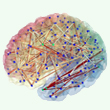Tuesday, 1 October 2013
We Are All Complex Networks

Before the Harper government’s budget cuts, the CIHR Institute for Neurosciences, Mental Health and Addiction (INMHA) had been providing this web site with stable funding for over 10 years. As a result of these cuts, the INMHA had to stop funding us. Now, because of the same cuts, we have had to stop publishing new posts on the English version of this blog every week and will instead be doing so only once every two weeks. We are truly sorry, but that is the best that we can can manage on a volunteer basis. So here is this week’s post. The others will follow at two-week intervals from now until further notice.
*
In some previous posts in this blog, I have talked about the RSA Animate knowledge-visualization videos and the Brain Science Podcast, and I promised that I would mention other videos in these two excellent series on occasion. Well the most recent RSA Animate video and the most episode of Brain Science Podcast complement each other so well that this week I want to tell you about both of them at the same time.
The RSA Animate video, entitled The Power of Networks (first link below), is a fascinating presentation by user-interface designer Manuel Lima on the veritable paradigm shift that occurred in the 20th century in the main metaphor that we use to help ourselves picture the complex world we live in. Basically, Lima relates, for many centuries a branching, tree-like structure had been our main model for placing the things in the world around us into a hierarchy. But as the 20th century continued and our knowledge of this world became more refined, was ending, the tree model gradually gave way to that of the network.
What people began realizing was that in most kinds of systems, the rule rather than the exception is that every element is highly interconnected with all the others. Whether we are talking about the way that human societies are organized, or the structure of natural ecosystems, or the Internet, a network with its many links in all directions provides a far more accurate representation of reality than a tree whose branches are constantly dividing in the same direction.
Which brings us to the 85th episode of the Brain Science Podcast (second link below), in which Dr. Ginger Campbell interviews Dr. Sebastian Seung about the Human Connectome Project. In an effort somewhat resembling the project to sequence the human genome, the Human Connectome Project is attempting to provide a complete description of the structure of the network of neuronal connections that form the human brain. It took scientists over a decade to determine the wiring diagram for the very simple nervous system of the tiny roundworm C. elegans, which has only 302 neurons, so mapping the interconnections among the 80 billion neurons in the human brain is clearly a very long-term project. Even so, many scientists like Dr. Seung believe that a detailed knowledge of these interconnections will give us a better understanding of the dynamics and the amazing emergent properties of the human brain.
And although every neuron may somewhat resemble a tree, with the long axon as the trunk and the dendrites as the branches, the connections that every neuron makes with hundreds or even thousands of other neurons creates an unbelievably complex network—a three-dimensional spider web whose architecture cannot be ignored.
![]() RSA Animate – The Power of Networks
RSA Animate – The Power of Networks
![]() SEBASTIAN SEUNG EXPLORES BRAIN’S WIRING (BSP 85)
SEBASTIAN SEUNG EXPLORES BRAIN’S WIRING (BSP 85)
![]() Sebastian Seung: I am my connectome
Sebastian Seung: I am my connectome
![]() Connectome
Connectome
From the Simple to the Complex | Comments Closed







